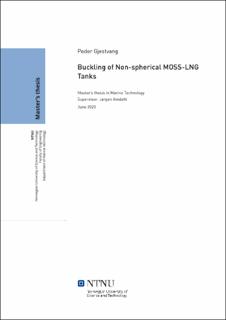| dc.contributor.advisor | Amdahl, Jørgen | |
| dc.contributor.advisor | Slagstad, Martin | |
| dc.contributor.author | Gjestvang, Peder | |
| dc.date.accessioned | 2021-09-21T16:31:28Z | |
| dc.date.available | 2021-09-21T16:31:28Z | |
| dc.date.issued | 2020 | |
| dc.identifier | no.ntnu:inspera:54166542:20963190 | |
| dc.identifier.uri | https://hdl.handle.net/11250/2780134 | |
| dc.description.abstract | Etterspørselen etter store LNG-skip har økt. Den enkleste måten å øke kapasiteten til Moss LNG-skip er å øke diameteren til de sfæriske tankene, og dermed også skipets bredde. På grunn av begrensningene på skipets dimensjoner i Panamakanalen, er ikke dette en ideell løsning. Dermed er det ønskelig å endre tankens form fra den sfæriske for å forbedre utnyttelsen av skipets deplasement. Denne oppgaven fokuserer på mulighetene for å "strekke" tankene i langskips retning, ved å introdusere en sylinderformet del, mellom to halvkuler. FEM-analysene har vært begrenset til knekkingsanalyser av slike tanker, og sammenligning med gjeldende regelverk for slike tanker er gjort.
Flere av analysene er gjort med kun ytre trykk som last. Dette er en enkel måte å vurdere hvordan styrken til tankene varierer ved ulike konfigurasjoner, som for eksempel sylinderdelens lengde. Å bruke kun ytre trykk som last er en enkel måte å finne kritisk spenning for tankene. I tillegg har sloshing-laster blitt analysert. Denne lasten er sett på som mer kritisk for tankene. Både en sfærisk tank og en langskips strekt tank med en sylindrisk del har blitt studert, og resultatene har blitt sammenlignet.
Resultatene antyder at DNV GLs bruk av likningen for elastisk knekkspenning for sylindre passer dårlig for sylindre med et så lavt lengde/radius forhold som slike sylindre vil ha. En modifikasjon til denne metoden, basert på resultatene fra analysene er foreslått i denne oppgaven.
Analysene med sloshing-laster indikerer at de strekte tankene er betydelig svakere enn de originale sfæriske tankene i forhold til knekking. Å øke tykkelsen på de strekte tankene i spesielt kritiske områder virker som en mulig og enkel løsning for å øke styrken. Dette vil dessverre også medføre økt vekt og byggekostnad. Basert på resultatene i denne oppgaven er det ingenting som tilsier at den reduserte knekkstyrken vil gjøre langskips strekte LNG-tanker til en umulig løsning. Det er vurdert som sannsynlig at andre strukturelle aspekter enn knekking av tanken vil være mer kritisk for en slik konfigurasjon.
Sammenligning av maksimalt tillatte spenningsverdier fra DNV GL og de kritiske knekkspenningene fra analysene indikerer at de foreslåtte maksverdiene fra DNV GL er konservative. Resultatene tilsier at maksimalt tillatte spenningsverdier fra DNV GL gir en sikkerhetsfaktor på omtrent to. Det er mulig at det å tillate høyere spenninger i tankene vil føre til mer lønnsomme LNG-skip uten at det går utover sikkerheten. Denne observasjonen er utelukkende basert på resultatene fra denne oppgaven, og videre analyse og verifikasjon vil være nødvendig før noen endringer kan gjøres i forhold til nåværende regelverk. | |
| dc.description.abstract | The demand for large LNG-Carriers has increased. The easiest way to increase the capacity of the LNG-Carriers of the Moss-design with spherical tanks, is to increase the tank diameter, and consequently the ship beam. Due to the limitations of the Panama Canal concerning ship dimensions, the remaining way to increase the capacity of the vessels is to modify the shape of the tanks to improve the utilization of the ship displacement. This thesis has focused on the possibilities of a longitudinally elongated tank, which includes a cylindrical part between the two spherical end-caps.
The FEM-analysis has been limited to buckling analyses of such tanks, and comparison with the current rules and regulations of non-spherical LNG-tanks have been done. Several analyses with only external pressure as load have been done to study the buckling strength of longitudinally stretched tanks, focusing on critical stresses and comparison with current rules and regulations. Additionally, the load assumed to be the most critical to buckling of the tanks, which is the sloshing load has been analysed. Both a spherical and a longitudinally stretched tank with a cylindrical part was analysed, and the results were compared.
Based on the results obtained in this project, DNV GLs use of the equation for elastic buckling stress for short cylinders seems unsuitable. A modification to the current Class Guidelines has been suggested in this thesis.
The sloshing analyses indicate that the buckling strength of a longitudinally stretched tank is significantly lower than the strength of the original spherical tank. However, the buckling strength can be increased by increasing the thickness in critical parts of the LNG-tank, although this will have some negative consequences in terms of weight and cost. Based on the results obtained in this thesis there is no indication that the reduction in buckling strength will make the longitudinally stretched tanks unfeasible, and it is deemed likely that other structural aspects will be more severe.
Comparison of maximum allowable stresses by DNV GL and the critical buckling stresses obtained in the FEA indicates that the maximum allowable stresses proposed by DNV GL are quite conservative, where the FEA-results indicate that the maximum allowable stresses by DNV GL have a safety factor of around 2. Hence, it is possible that allowing larger design stresses in the tanks may lead to more cost-efficient LNG-Carriers without introducing safety issues. This observation is based exclusively on the results obtained in this thesis and would need to be verified before introducing any changes to the current rules and regulations. | |
| dc.language | | |
| dc.publisher | NTNU | |
| dc.title | Buckling of Non-spherical MOSS-LNG
Tanks | |
| dc.type | Master thesis | |
